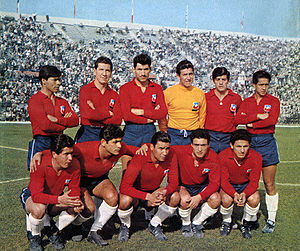When I look back on my primary school years, my principal flashes back distinctively for the use of two phrases; “Try your best and God will do the rest”, and “if at all you don’t succeed, try and try again”. The latter, probably the motto by which the Chile National Football team founded their success upon capturing their first Copa América triumph in 2015.
The Chile National Team or La Roja (The Red One), is one of the oldest footballing federations. Managed by the Federacion de Futbol de Chile, it was established in 1895, the second oldest in South America. They along with Argentina, Brazil, and Uruguay comprised as the four founding member nations of CONMEBOL (the South American football confederation), who later on competed in the first South American Championship, later to be renamed the Copa América, in 1916.
La Roja have appeared in nine World Cup tournaments and played hosts of the 1962 World Cup where they were able to claim their best position in a World Cup, finishing in third place. Yet with all this history, the great players throughout the decades could not bring a trophy to the eastern shores of the South America until the 2015 edition of the Copa América.

Much was expected from Chile, as the 44th edition of the Copa was being held in their country, and with a well-balanced group of recognised world class players, the country would accept nothing less than the top prize.
With two convincing wins against Ecuador and Bolivia, and a thrilling draw versus Mexico, Chile topped the Group A standings and were paired with the defending champions Uruguay in the quarter finals. Playing at home before an expectant crowd, the boys did not falter, as they faced a Uruguay side refusing who relinquish their title without a fight. Mauricio Isla’s effort in the dying moments of the game guaranteeing the 1-0 victory. A 2-1 victory in the semis versus Peru would pair them with mighty Argentina in the final.
With the expectations of an entire nation on their shoulders, Chile went into the final game praying that 2015 would be their year; Argentina themselves were hoping for the favourable result, looking to avoid two finals defeats in two years after losing the 2014 World Cup final to Germany.
In a competitive encounter, the game would end in a 0-0 draw with both sides unable to capitalize on their opportunities; warranting a penalty shootout. In a raucous atmosphere, the Chileans held their nerve showcasing some ruthless penalty taking. For Argentina, it was the exact opposite, as captain Lionel Messi was the only player to fire past Chile keeper Claudio Bravo. Alexis Sanchez then stepped up to slot home the decisive penalty in style and send the entire country into pandemonium.
Fast forward 12 months later to Copa América Centenario. The competition was a celebration of the centenary of CONMEBOL and the Copa América, and was the first time being hosted outside of South America. The 2016 edition featured an expanded 16 teams rather than the customary 12, as 6 teams from CONCACAF (the football confederation for North and Central America and the Caribbean) graced the tournament.
The Chileans, coming in as defending champions knew that repeating success of the previous year would be no easy feat. Drawn in Group C along with losing finalists Argentina, they began their title defence in a grudge match versus an Argentina side without Leo Messi, who edged them in a 2-1 defeat. They would bounce back in their next two games, as doubles from Vidal, Vargas and Alexis Sanchez ensured they got the better of Bolivia and Panama to finish second in the group behind Argentina.
La Roja were playing well and next up for them were Mexico in the quarter final round. No one would anticipate the result on the day. Juan Antonio Pizzi’s team humbled the Central Americans with a 7-0 demolition job, which included a quadruple for Eduardo Vargas, as they dished out the worst ever defeat to the Mexicans in their history.

Colombia stood in their way as they went into the semis. Led by Real Madrid’s James Rodriguez, they were looking to get a shot at the title; with their last finals appearance coming in 2001 when they prevailed for the first time ever, on home territory. But these aspirations were vaporized early, as Chile hit two goals inside the first 11 minutes and held on to book their place in the final for a second straight year. An intriguing prospect simmered, as a repeat of the 2015 final beckoned, with Argentina also booking their place for the second year running; this clash now developing into a rivalry.
Messi and co. were looking like an unmovable force, after defeating Venezuela 4-1 in the quarters and then dispatching host nation USA 4-0. They came into the finals as the favourites, and were looking to avoid a hat trick of finals defeats. Starting off the brightest, they looked to strike first with the best chance falling to Gonzalo Higuin, but the forward failed to hit the target after being set up nicely with a one v one opportunity.
Chile settled themselves as the game went on and looked like the more composed side on the day, but neither side could find the finishing touch. For the second time in two years, the Copa América final would end scoreless after regulation and added time. As always, penalty shootouts demand levelheadedness, precision and “nerves of steel”, and both teams had so much riding on the 10 spots kicks.
In dramatic and inexplicable fashion, Arturo Vidal saw his penalty saved; and then reality seemed to fade, as Messi blazed his spot kick over the crossbar. With that lifeline given to the Chileans, they would capitalize to full effect, as they emphatically slotted their remaining penalties. Javier Mascherano and Sergio Aguero kept the Argentines hopeful, but Claudio Bravo produced a save of his own, denying Lucas Biglia. Francisco Silva then ensured that Chile repeated as champions, as La Roja snatched their second consecutive title 4-2 on penalties.
As the world emphasized, magnified and critiqued Messi’s penalty miss, Chile and its people celebrated their latest Copa victory. Once South America’s great underachievers, they are now one of only five nations to win the cup on more than one occasion. And with players like Golden ball award winner (player of the tournament) Alexis Sanchez, along with Arturo Vidal and Eduardo Vargas, the people of Chile are surely perceiving that this crop of players represent their golden generation.



